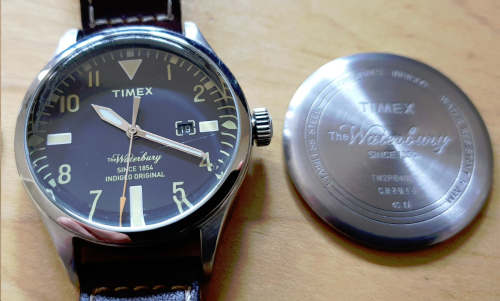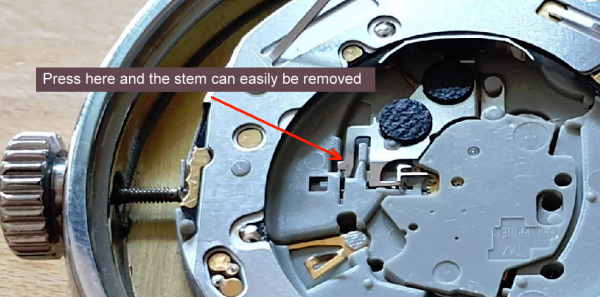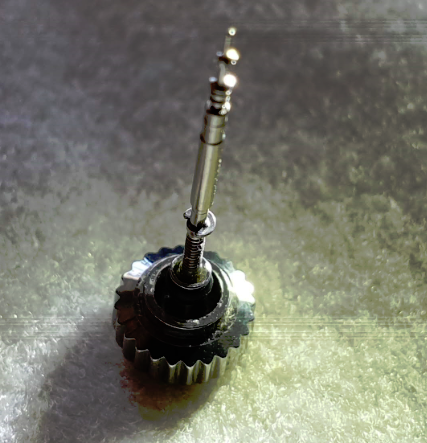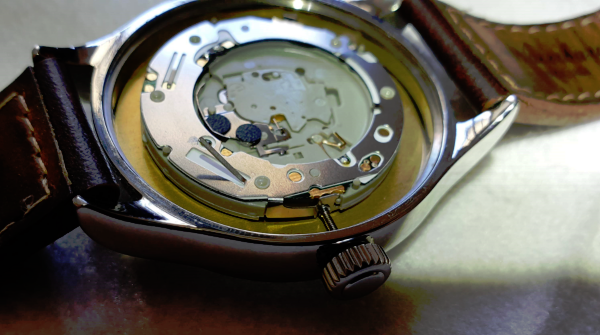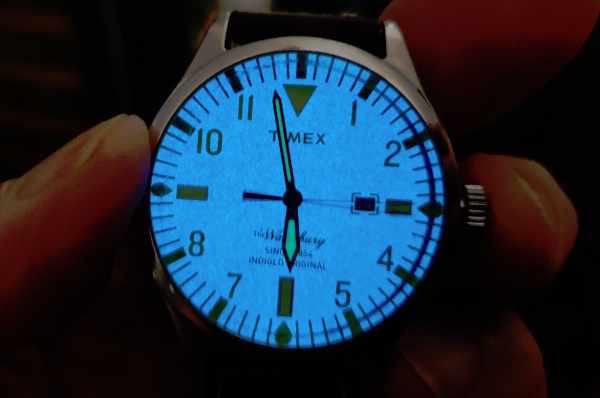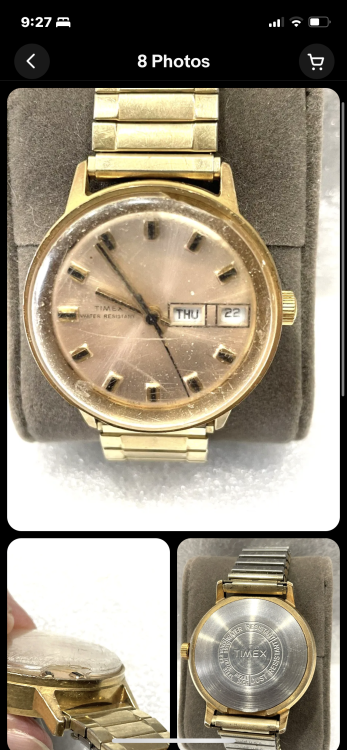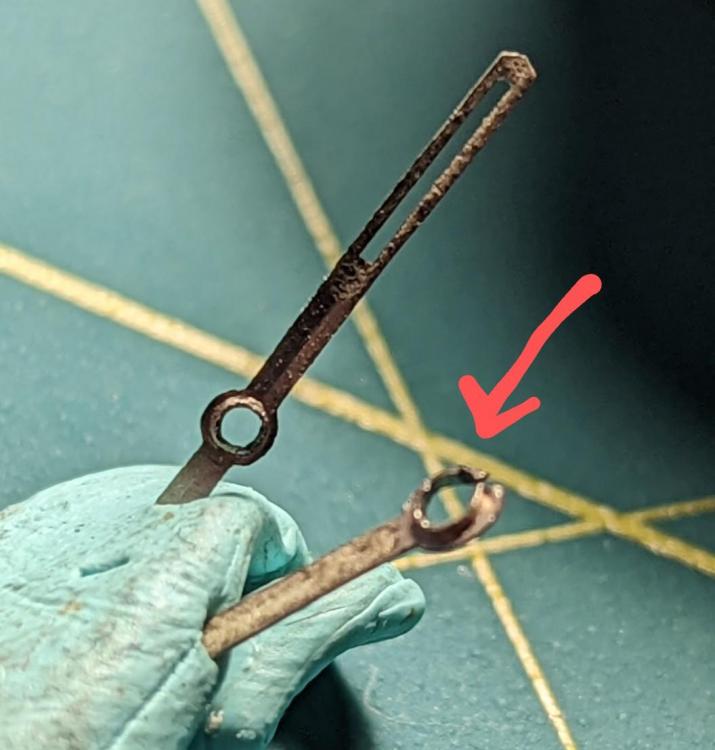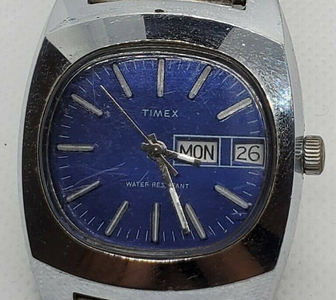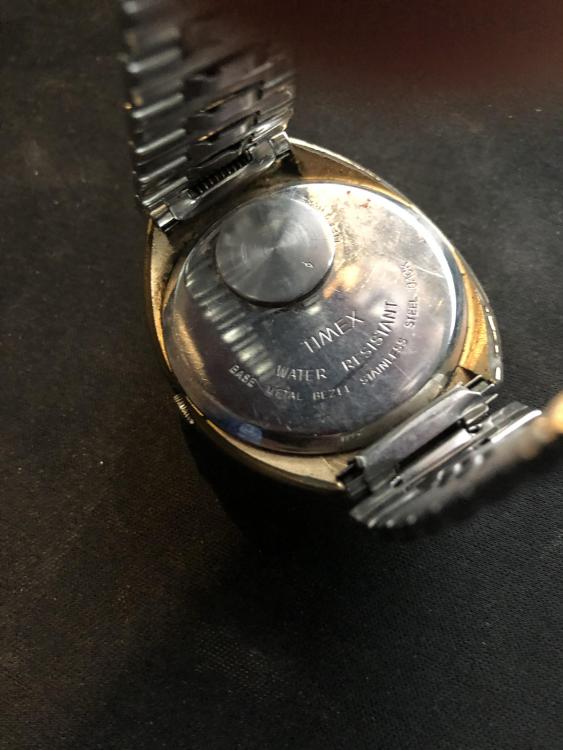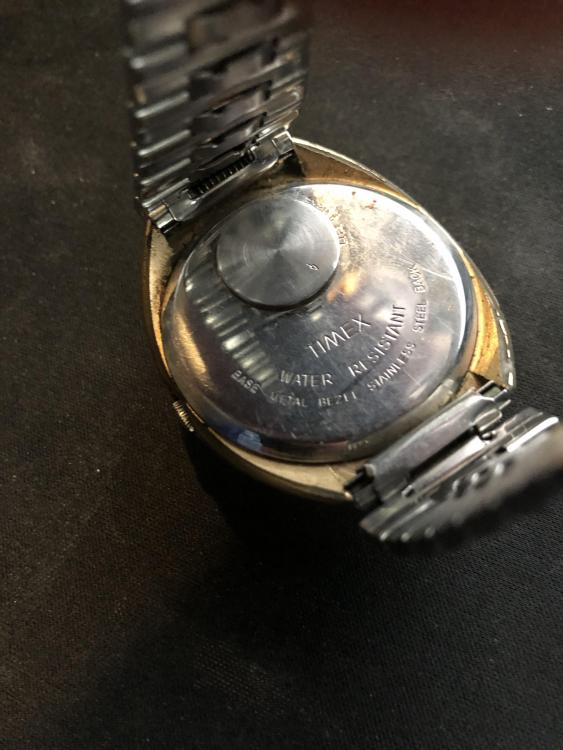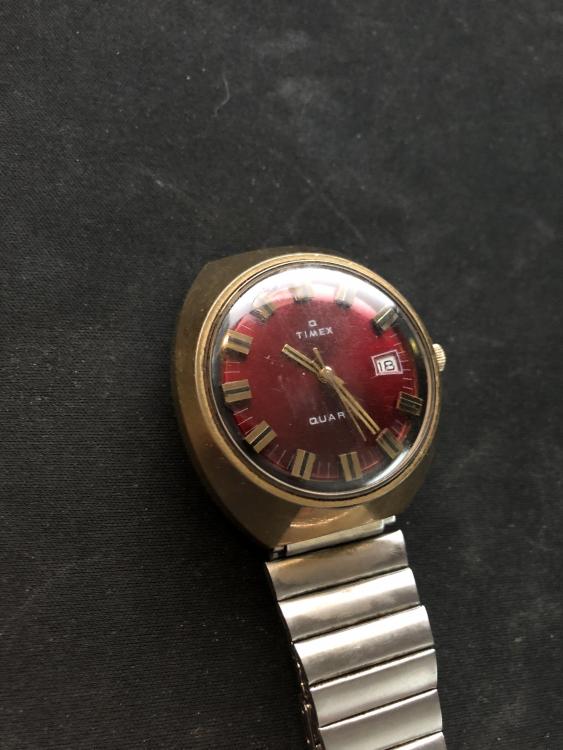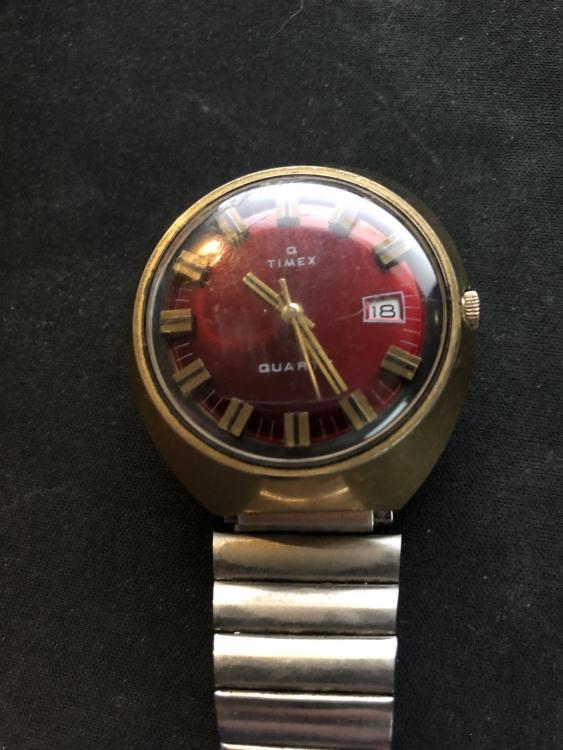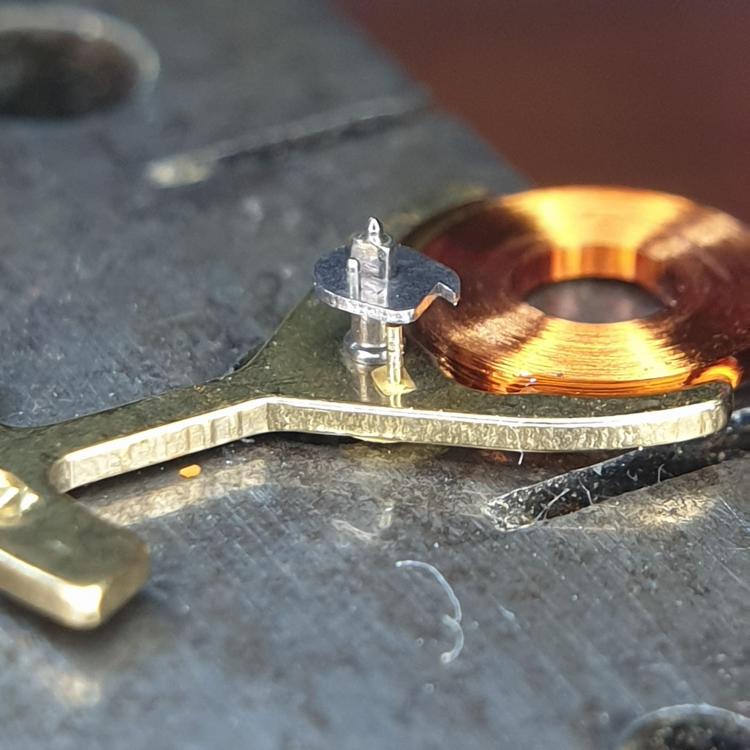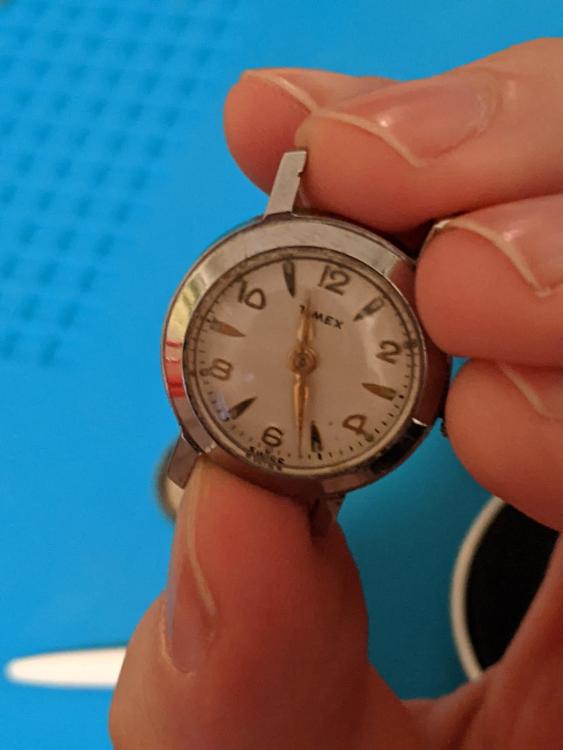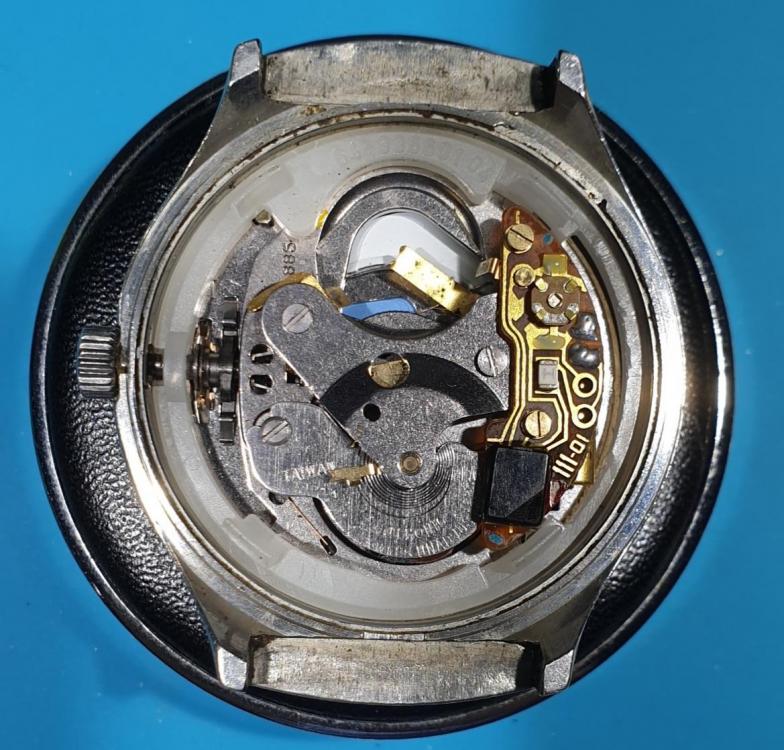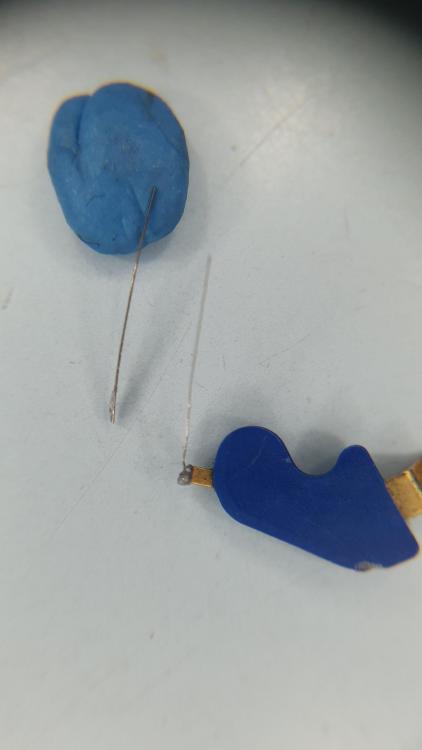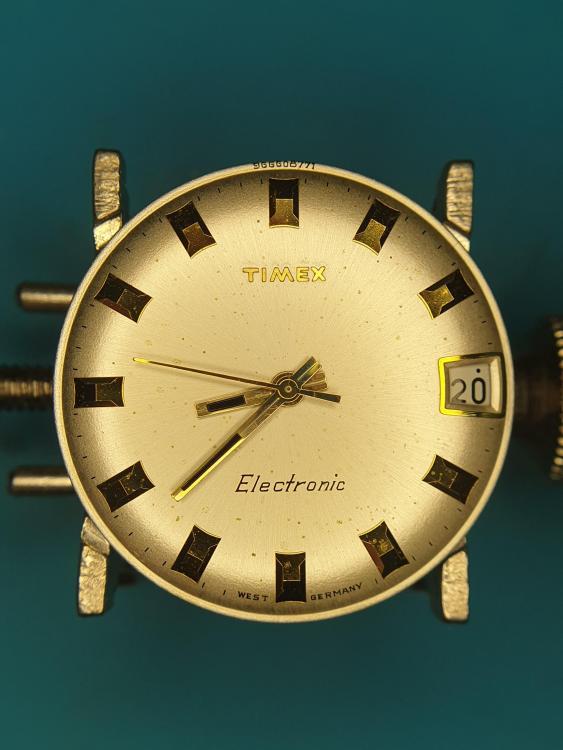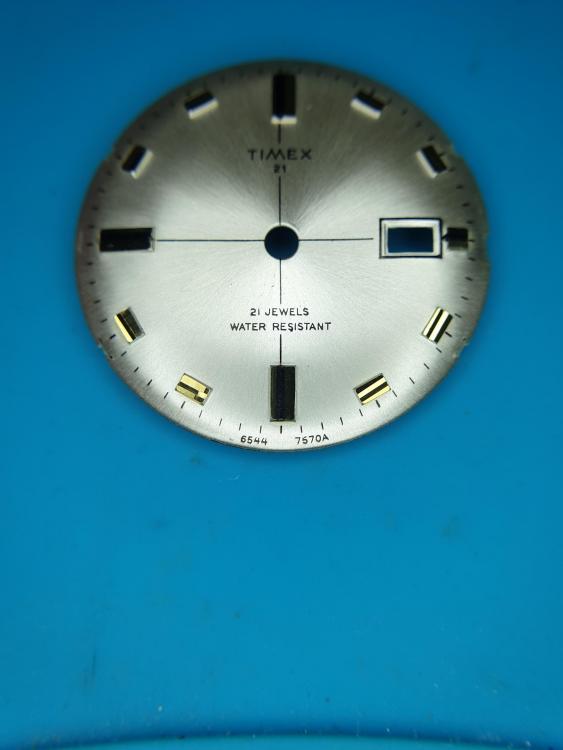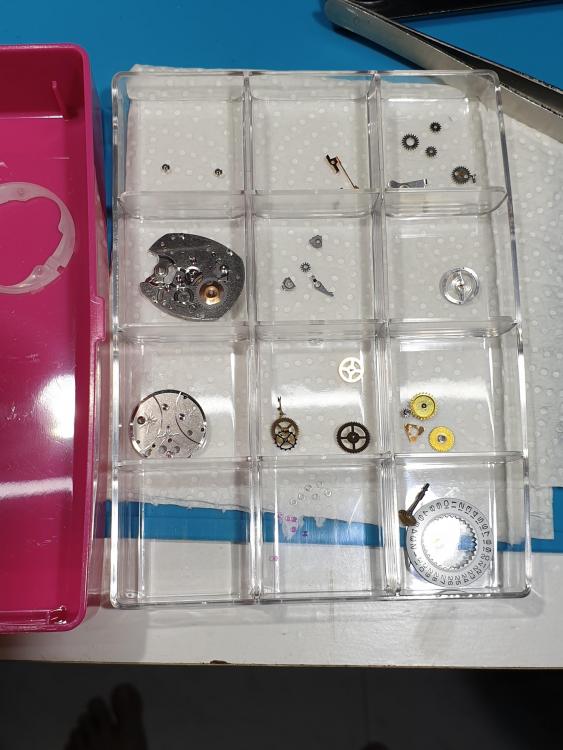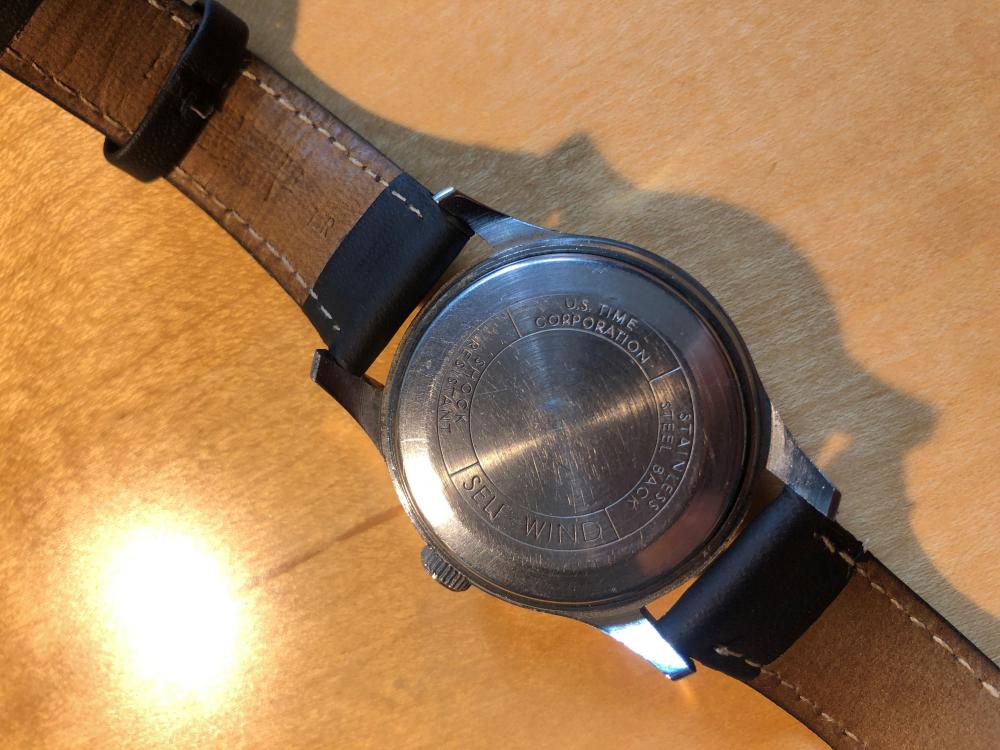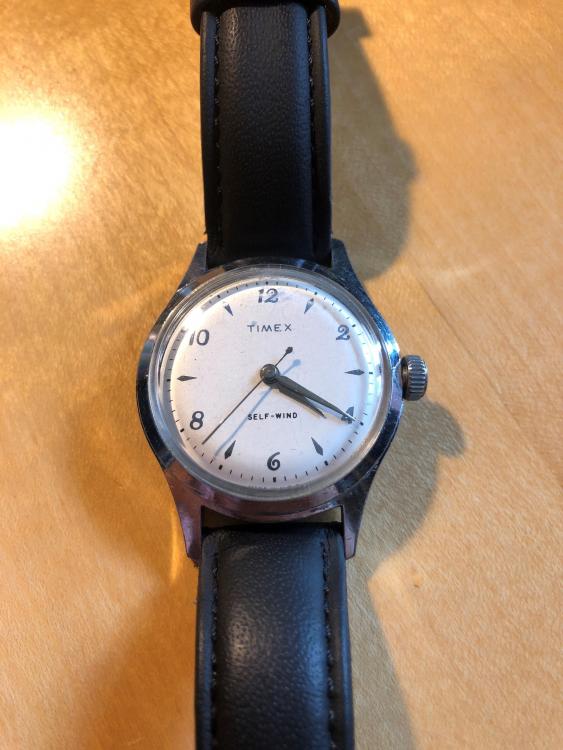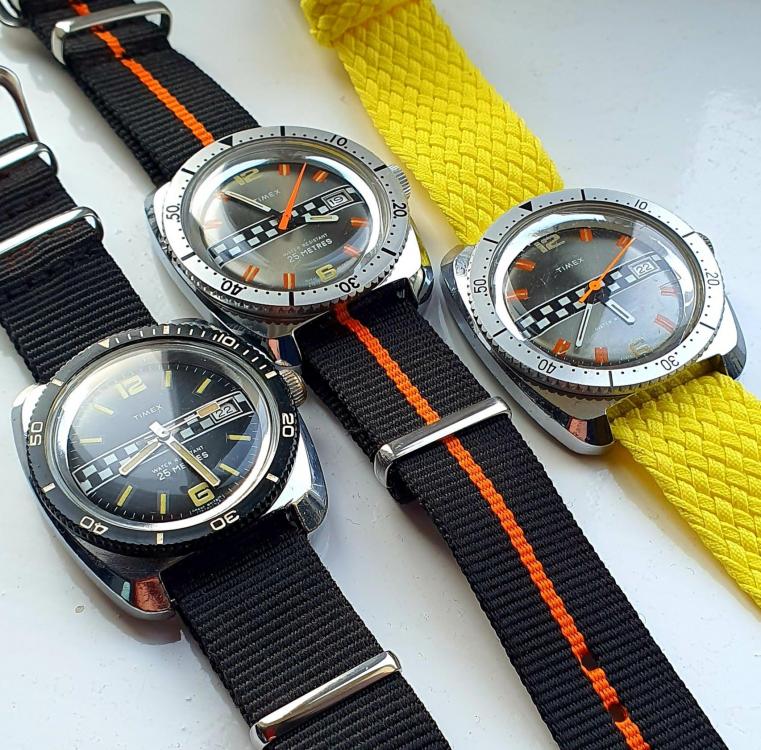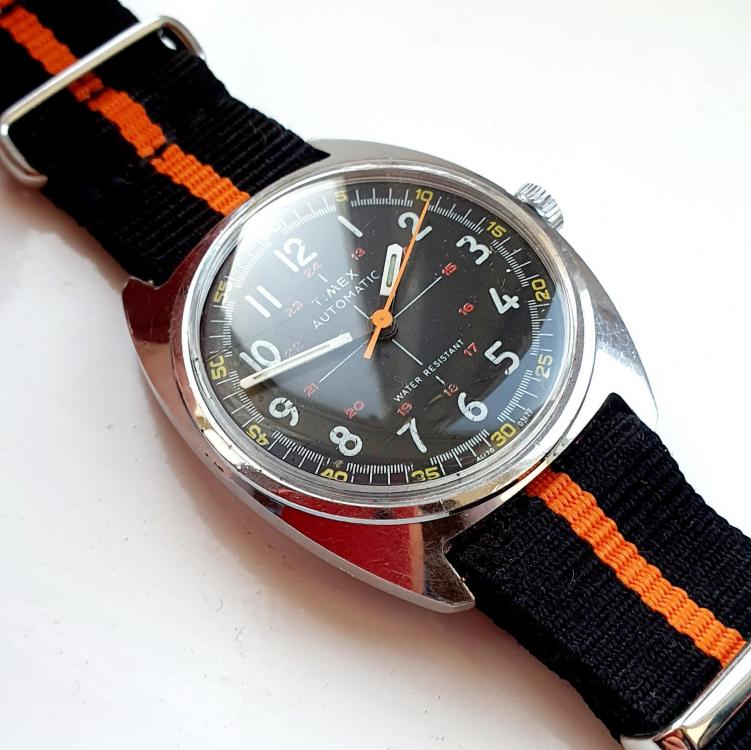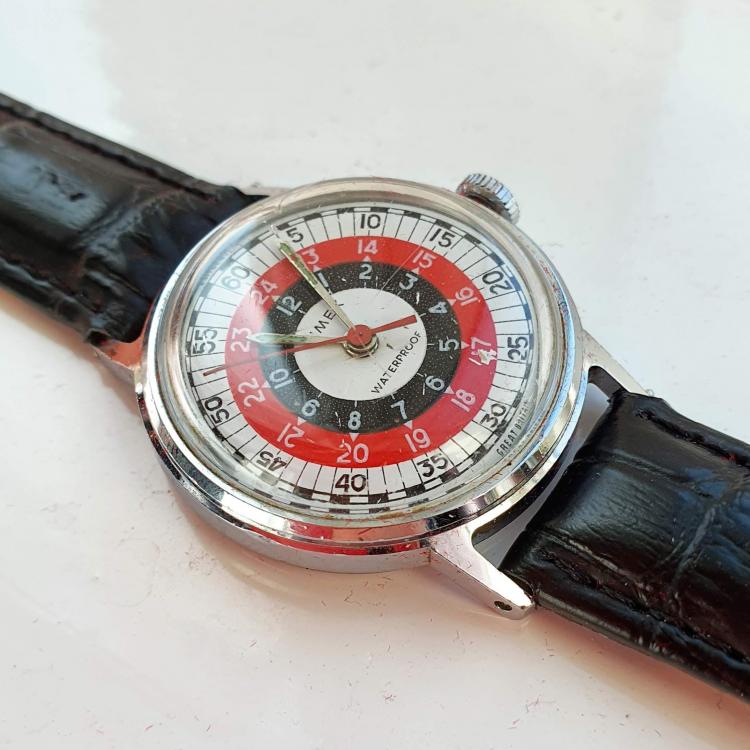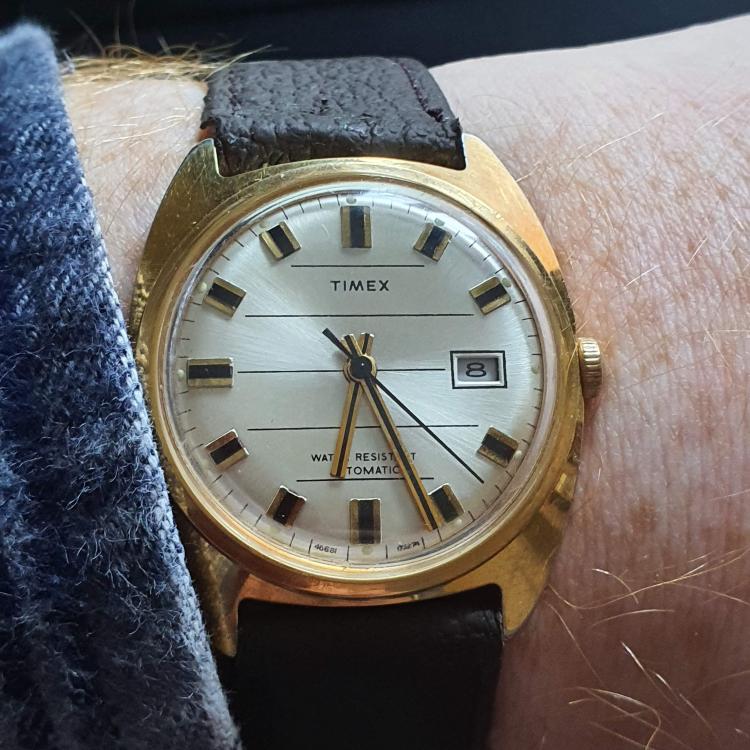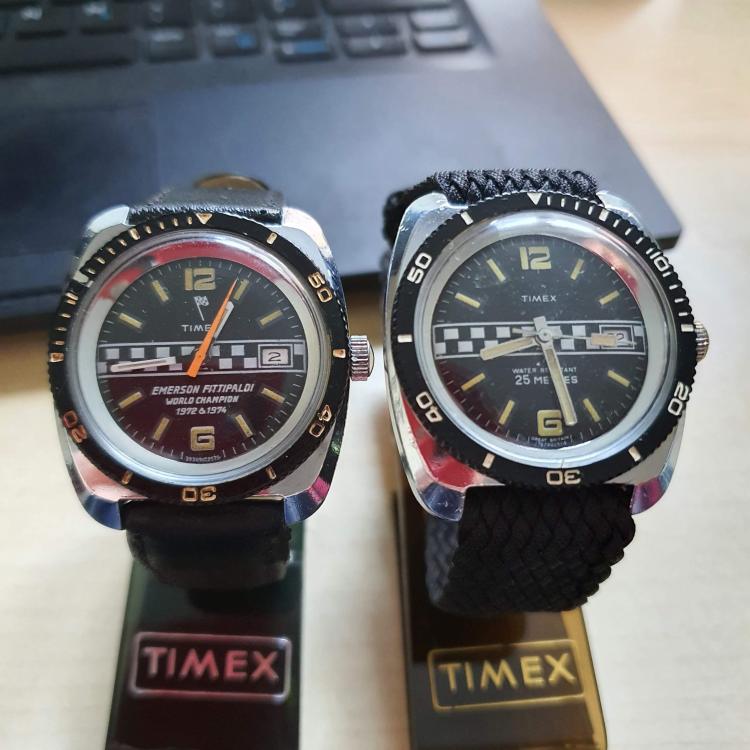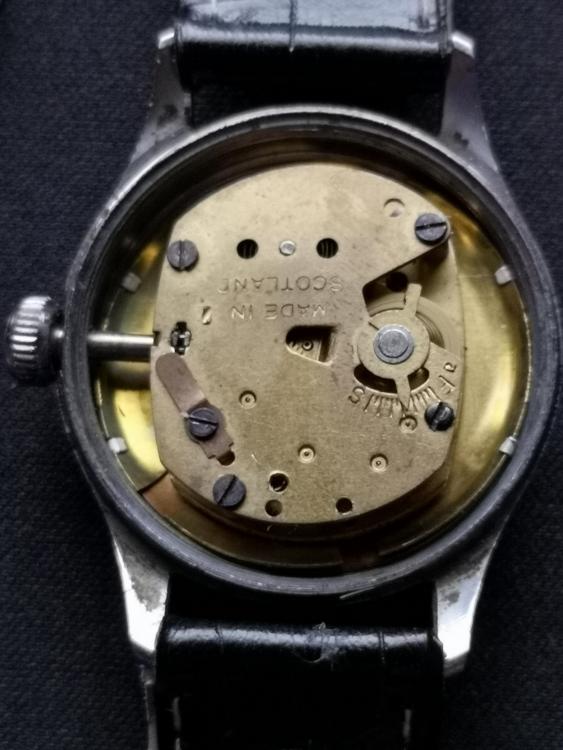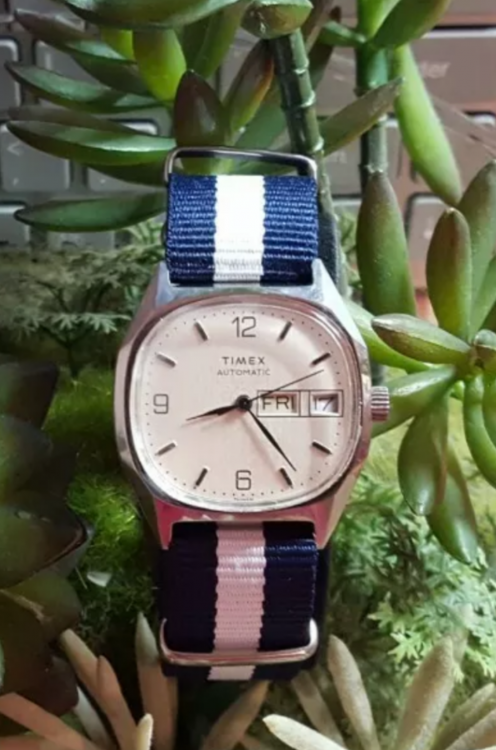Search the Community
Showing results for tags 'timex'.
-
My Timex Waterbury 2018 backlight was intermittent from new. This was a 60th birthday present which I really appreciated so I didn't want to try and return it in the heat of the Pandemic. After about a month the Idiglo stopped working altogether even though the watch keeps excellent time. The illumination itself was working fine when it worked at all. The problem was that pushing the watch crown inwards to activate the light seemed at fault. Towards the end I found I had to pull the crown out slightly and then press to get the light to come on. This ran the risk of accidentally changing the position of the hands which meant I couldn't trust the time afterwards. It was getting annoying! Following advice in the forums I used a stout bladed knife and popped the back off by lifting the tabbed part against the nearest lug. Replacing the back was going to be very tough but more on that later. The scratches on the crystal look terrible in this picture but it's hardly noticeable in reality. The fault did appear to be with the on/off switch mechanism so that's what I went looking for. When you press on the crown the sprung lever should be pressed against the gold plated electrical contact and complete the circuit for the light. The spring then returns the crown, the circuit is broken and the light goes off again. Ok so cool. I know how it is supposed to work now but it's so simple, how can it not be working? To make matters worse it did work absolutely perfectly with the back off! So I figured that I had mended it and put the back cover back on. This was VERY HARD. I couldn't press the thing hard enough to make it snap back and all that happened was that the cover 'see-sawed' around and I started to worry that I would damage it. So in the end I pushed the cover as far into position as I could and then clamped it between two pieces of wood in a table vice. Protecting it with layers of paper towel I gradually increased the pressure - fully expecting to crush the crystal - until it popped back on. I'd been very careful to clean the surfaces around the seal and replace the rubber gasket without any twists that might compromise the water resistance. But the backlight was still faulty. Exactly the same. I guess the stem was touching the lever while the back and retaining parts were removed. I took the back off again and decided to go a bit further this time. The stem was removed very easily by pressing the little locking tab. I don't have a picture of it happening but when I was handling the case to get the stem out a tiny, tiny circlip fell out as well. About 1.75mm diameter. I'd never seen one of these things so small! Here's a picture of it close to the groove it should be clipped into. I know that holding it with a magnetic pick could risk magnetising it but I tried tweezers and immediately realised that the tiny thing would go flying into orbit and be lost forever. How am I supposed to get the circlip into the groove without it disappearing across the room? The answer was Blu-Tack. I pressed the circlip into it with the open part upwards and then pressed the watch stem down on to it until it clicked in. Result!! And that was it. I replaced the stem and did the scary vice thing again to replace the back and it was done. Good result! Considering how many Indiglos have been sold around the world I was surprised that there was just nothing like this on the internet so I'm posting to help others in the future. It was pretty easy to do once I knew what was needed. But it was also VERY fiddly and you really should be aware that losing the circlip or crushing a watch in a vice are likely to void your warranty! See you out there, Moo
- 6 replies
-
- 9
-

-

-
- back light
- backligt
-
(and 4 more)
Tagged with:
-
Hello. I have purchased a Timex Marlin 1973 day date and will need to change the Crystal. It’s missing a chunk out of it. Can someone please let me know what size and the best place to order this from? I’m hoping Jersey Mo will shed some light on this for me. This is my first post aside from introducing myself . I’d like to order the Crystal now before the watch arrives. It was an eBay score for $15 delivered. Thank you for any advice and I’m looking forward to some great conversations. Everyone I’ve met in this hobby has been great to know. 26860-2773
-
I just received a Timex Electronic in the mail a couple of days ago. It still had the original Timex Type A battery inside. But luckily it hadn't leaked. The hand setting is fine, but the day/date function seems to be stuck. The balance is able to swing freely. A quick test with my Accutron test meter shows that the coil is still ok. How is this movement different from the Timex Electric? At 1st glace it looks identical. How do I get to the calendar works? Do I need to pry open the dial tabs to get the dial off? I hate doing that. I just can't get the dial factory tight again. Thanks in advance.
-
Hi there - Reassembling the dial and hands on a 1978 TV case Timex I realized the hour hand is probably not correct and want to source a proper one. However I don't know what I'm searching for because I don't know what this type of hole is called. These hands have a small collar on the underside of the hole, while I've only dealt with flat (hole only) hands before. The hour hand must have this collar because the cannon pinion on this watch sits partly lower than the dial surface. What's the name for this kind of hand? I'm pretty sure this is the wrong hour hand because 1) it does not match the minute hand which has a tail, and 2) it can touch the index at 12 & 6 because it's too long. Also, the dial is marred up in the center where someone has carelessly removed hands in the past. A similar model I found a photo of had a far shorter hour hand. And a related question about the sweep seconds hand - this watch did not come with one but the movement (Timex m104/106) should have one. The Ranfft page for the movement specifies: Hands 1.38 x 0.90 x 0.16/0.21mm (second hand without/with bushing). What is meant by "without/with bushing" in this context? Am I looking for something special, or can I get an everyday seconds hand with a 0.16 or 0.17 hole? I tried a 0.20 and it stopped the movement. Thanks for reading!
-
Hello everyone, I recently inherited a Timex Time Machine (1972) from my late grandfather. This was a watch that he used to frequently wear in his younger years but at some point I assume the watch stopped working. After inheriting it I decided to take it to a watch repair shop to see if it needed a battery. Once the repairman placed the battery in the watch it started ticking only for a few seconds. He explained that the watch was wanting to tick but due to this model being a hybrid piece (half mechanical and half quartz) it would be incredibly hard to repair. He was not exactly sure but he believed that it was possible that one of the circuits was fried, due to the watch ticking for only a few seconds after shaking. He explained that the main spring was able to move but due to circuit not working the polarity of the magnets was not able to wind the watch. So this brings me to my current situation. I am just looking for a place with answers because there is very little information online about this watch. If anyone knows where I could find a replacement movement, either an M62 to match the current or possibly a movement that would fit inside my current housing and allow it to tick I would be very grateful. Any help is appreciated -LB
-
I have a few watch tools and have been messing around with old vintage American pocket watches. I have gotten to a point that I feel comfortable takeing them completely apart and cleaning and reassembling them. Oil and also replace crystals as needed. I have also gotten into buying old Timex and trying to refurbish them.
-
A couple of weeks ago a member asked how to measure the coil resistance of a Timex Electric. As I'm working on a dead Timex Quartz, I took some photos to show how it's done. May I ask what kind of meter I should use to test the coil? I'm having what I believe are coil problems with my watch. Also need to check for completed circuit. If you look at the above photo, the coil terminates on either side of the balance staff. The one on the left is the common ground and the one on the right goes to a pin that will touch the contact wire. On the other side, the contact pin is just under the roller table. So to measure the resistance, you must contact this pin and any metal part of the balance. Hope this helps.
-
I have on my bench a Timex Automatic (would it be a Viscount, circa 1979?) marked 37869 10979, 38 mm dia. with day & date. Symptoms that the owner/dealer wants me to correct are 1) the stem does not seem able to find that first detent where the date & day can be set, and 2) crown is unbelievably worn down and he wants a new stem-&-crown if I can get one. I think I might need a new setting lever too. So far, the impression I get is of a degree of wear. The stem *seems* to slide in and out almost too easily. And I can't get it to stay in that sweet spot where the day or date rings turn. I will be stripping it down further in a bit, but I wanted to hear if this might be a common problem. I'm also hoping @JerseyMofinds this.
-
I recently came across this while digging thru a bag of watches. It looked interesting and all of the Google hits for "Swiss Made Timex" are in reference to the American Documents series. I've got to assume I'm not searching the right keywords. I was hoping somebody might have a little information on the subject. While looking recently, I couldn't locate almost any Swiss Made. Most of the watches I did find were quartz movements. Thanks for any insight the community can muster!
- 2 replies
-
- timex
- information
- (and 4 more)
-
Hey, new to the hobby and found myself starting with old timex watches. I have found that when I swapped my m24 movement with an m72 movement my second hand will slip and fall to the 6 o'clock position when the face is held perpendicular to the ground. Any ideas for a newbie?
-
I just received my Timex Q Quartz. It is running fine but appears to have fungus on the dial. Battery hatch gasket was missing and the case gasket was damaged. Full of lint inside. There was a whole ring of lint wound around the winding stem. Looked like a felt washer. And I found another "felt washer" under the hands. Should have taken photos of it to see if it would win any prize. In spite if all the foreign bodies inside, the watch was still keeping good time. Can anyone identify the movement inside? I would be grateful if someone could post the tech sheet for this movement.
-
Attempting to produce a contact wire for my Timex Electric. I thinned down a piece of spring from a broken mainspring. It's getting a bit difficult to hold now.
-
This was sitting in my junk pile for some time. I was looking for a spare contact wire for one of my Timex Electrics, and I remembered that the Timex Electronic has a contact wire. But when I opened it up, it was a totally different beast inside. The movement number on the dial plate is 882, which I checked up is a M87. The balance appeared fine. So I put a battery in to see if it would fire up. And it does! After cleaning it up, it doesn't look half bad. And now I have to continue searching for a contact wire....
-
I've recently encountered the world of Timex watches. As everyone knows they are still in production and the new Timex watches are all quartz. But the line goes back decades. I myself have bags of discarded Timexes. Been fiddling with them recently. I've had a few flops but I'm surprised as how robust they are. Even my paws seem sufficient to revive some of them. Recently spent a pleasant half-day working on an old 50-60's era men's mechanical. Polished the case, buffed the crystal, did a partial disassembly of the movement, popped the whole thing into the cleaner. Came out looking like a new watch. Put the balance back in (and made a bit of a mess of it) and it works. Seems to keep good time in spite of my faux pas (paws!). It would be fun to get a bag of watches working again. Anyone know how to service the Timex Electric; the analog mechanical watch coupled to a solenoid (or something like it) which was used to provide a push to the balance to provide timing and energy. I have several. They look like they'd work but I doubt they would with modern batteries. (???) I've perused several threads here from like minded individuals who, like me, love these humble little pieces that lack all pretense yet "do their duty" faithfully. How can we share information? I really would like some tips/tricks/gadgets etc. that would make restoration easier and safer.
-
I started disassembling this Timex 21 jewel M75 last night. Having an obsessive compulsive nature, I couldn't stop at just removing the calender works and soaking the movement in naptha. I removed almost everything except the mainspring. Including every endstone. I have not seen any other watch with so many endstones. My question is, what oil do I use for a Timex? Do I use the whole gamut of D5, 9010, 9415, molykote DX...? All other Timex posts on this forum only mention oiling but don't talk about what oil to use. I'm sure JerseyMo must be shaking his head and laughing so hard now.
-
One of the great things about collecting and repairing is that feeling of taking a bunch of parts and making a working watch again. This restore begins with a scrap pile of cases from a former Timex repair center. I chose a late 1960's Marlin case that is missing the stem tube. So to the parts stash and one issue resolved. Off it than goes to get a bath in cleaning solution , polished, new crystal added along with correct case back. Next I service a used #24 movement also from the same lot the cases came with and the assembly begins. Since the hands are chromed, I just use an old eraser pencil to bring back their shine. The sweep comes from NOS stock. Grease the stem tube, set lever, insert a NOS stem\crown, snap on the case back and there ya go. Will give this one a wear to test its time keeping.
- 10 replies
-
- 13
-

-
Hello forum, this is my first time posting. I found my great-grandfathers Timex maybe about a year ago, and to my dismay, it wound right up some 50 years later. From what I can tell, it looks to be a viscount model maybe pre-1960s? Possibly closest to a model 31 movement. My area of expertise is really limited to owning battery operated watches, so I'm hoping someone could help. I was using my hand to hit a wrench for my car and I didn't even notice I had my watch on. The movement stopped and from then on it's been acting funky, basically just stopping randomly throughout the day, but then restarting. When I take off the case and manually wind the rotor with my fingers, it will continue to run for quite some time, but once I try to wind it with the crown and stem or maybe even shake the watch it may only last a few moments. I hope someone may be able to help me diagnose some potential sources of this, since I would love to keep wearing my great-grandfathers watch. I've attached pictures too
-
Good afternoon everyone I'm hoping that someone will be able to help me get an old Timex Diver watch up and running again. So, as I said when I introduced myself, I recently found my very first watch, an orange faced Timex Diver which I got for Christmas in 1973. My 7 year old daughter has asked me if I can get it repaired so that she can use it. Now I will be the first to admit that I don't know anything about watch repairs but I am a 'have a go' type of fellow and manage to fix most things myself, usually with a little advice from knowledgable people. The story so far is that you can see from the first photo that the winding stem / crown assembly is missing and on removing the back case, that the retaining lever and screw are also missing. According to my Dad, I overwound the watch as a boy and the watch repairer said that it was not financially worth fixing. That would have been around 1977. The Diver watch identification number on the dial is: 23772 2573. From my research, the first number is the watch case identification number and the second number is the watch movement number and the year of watch manufacture. In which case, it has an M25 movement and the watch is from 1973 but I am unable to find a part number for the stem and crown assembly other than it starts: 401/1 TXJ1 ........? I also have an old 21 Jewel Timex watch which keeps very good time and has an identification number on the dial of: 6544 7569. I am led to believe that dimensionally, the M25 movement and the M75 movement are the same. The difference being that the M75 movement uses rubies for bearings rather than hardened alloy. If that is the case, I'm hoping that if I swap the dials and hands over, I could use the M75 movement in my old Diver watch. Obviously, I would still need to find a winding stem / crown assembly to fit the case as the one on the 21 Jewel watch looks too long. See photos attached. My first question is: Are the two movements interchangeable? My second question is: If the movements are interchangeable, does anyone know what the part number is for the winding stem / crown assembly to suit my watch case (23772)? And if so, does anyone know where I might be able to buy one? Any help or advice would be greatly appreciated! Many thanks in advance, Grae
-
hi guys, my obsession is early Timex watches from the 1950s, 60s and 70s with a particular focus on 1976 birth year watches, Dundee made pieces and early 50s pieces. what attracts me to Timex is how disposable they were and how they shouldn't have lasted as long as they should. there's a UK connection and a wide range of mechanical pieces produced in 1976 when the quartz crisis was at its height. unfortunately i have the money but not the time to restore many of these pieces so for now stick with m24 (no date) restorations with others being helped out by the timex community on fb and ig. (@timetrope) my current challenge is getting date wheels on m25 movements back on. theyre tricky. and getting crowns to stay in place on m21/22 movements which im hoping some new antimagnetic tweezers will help with. if your looking to sell or trade pieces then my goal is to collect them ALL and even at 200 im short quite a few
-
I've just put a '67 Timex Viscount auto back together and I'm having a strange problem where the hour hand doesn't keep up to the minute hand (noticing this while setting the watch) and then it bolts ahead an hour or more very quickly. I've had to adjust the lay of the minute and second hands because they were rubbing every once in a while and stopping time. Perhaps I pushed the hour hand down and it's rubbing on the face now? I have to open it up again anyway as my micro-adjustments of the minute hand aren't keeping it away from the second hand consistently. It could just be that I need to make sure everything is getting clearance a little more closely or could it be something with the way the hour wheel and cannon pinion assembly are meshing?
-
Evening, Adam here, Ex British Army, currently working as an Network Analyst. Naturally I'm here I'm here to ask a question! After scouring the Web for an answer, I'm lost. Recently I have become obsessed with purchasing old manual wind Timex from ebay, never more than £10-15, in an attempt to get them working. This is my first time looking at a M22 and can't figure out how to remove the stem, and struggling to find solid documentation. Hopefully this is a simple task which someone can help? Thanks.
-
Been struggling through a number of #31 movements. This particular one was bought as a "running" watch, but it's been anemic from the start with some 80° of amplitude, just no momentum at all. I've cleaned it, oiled it, checked it and repeated some 3 times now, with nothing seeming to help. One thing I've noticed is that the unlubricated movement always sticks hard on the trailing palette pin. Give the pin or balance wheel a flick and the escapement wheel kicks the first pin out easily and then hangs on the 2nd. I've lubed the pins before (which is a bit tough) and this (along with other general oiling) gets it going with the poor amplitude, but never for long. Could the pin be bent in towards the wheel? Doesn't look it. Hairspring seems nicely shaped. I've lubed both pivots of the balance shaft and attempted to remove end-shake, but that adjustable brass pivot is getting pretty mauled. I'm really trying to avoid taking this movement apart completely. Any thoughts? Thanks!
-
Fixing a Timex Electric (Dynabeat) Watch (battery) from the 1970's.....with battery will run only 3 to 5 seconds once shook. Battery compartment is clean & sanded contacts. I pulled crown / stem out & sets & moves hands (....when pushed in I can shake/rotate watch & will run for 3 to 5 seconds , ...... with stem/ crown pulled out , will not run....) I believe this is normal......The watch insides look very clean , no corrosion nor battery leakage.... Can any members give me some information on what direction I should take on this problem? I believe this is a battery conectivity within watch movement.....are there any diagrams showing the inside of the movement & how the movement works.....battery & mechanical. Thank you in advance for your help.....Dan
- 13 replies
-
So there is this timex automatic i found online from a reputable seller. I cant find much about it anywhere. Ive been looking for a timex automatic but already have a few watches that look like the marlin. This one is a little different and i like it. Any info would be greatly appreciated
-
Hi! I'm well aware that Timex's don't get a lot of love and are known for not being so easy to work with, but mine was my father's and I'd like to get it working again. By the time I found it 3 weeks ago, I'm pretty sure it hadn't be worn in 35 years or so, but with a little wind and steady wearing, it started working and didn't keep bad time. At the end of a couple weeks, I'd noticed it wasn't keeping time and often running out of power after short periods. Eventually it stopped altogether. Being an overconfident novice, I found its manual online, did some reading (here and other places), and proceeded to take it apart, thinking I was being careful and looking for the obvious. Well, I never did figure out what was wrong, but in the process of putting the watch together and apart several times (NOT easy lining up all the pins and stem assembly), I stretched the hairspring into a nice tornado and that essentially killed the project... Ticked off that I screwed up my Dad's watch, I found another one like it on ebay that expressly said it didn't work. It's in equally good shape and when I opened it up, it was wet inside. I couldn't make out if it was water or a fine oil, but I ended up soaking the movement in lighter fluid hoping for a clean and a dry out. It did dry it out fine, but didn't magically start working even though I could see and feel that the mainspring held a wind. I used my oiler and Mobius oil in the divots of all the pivot points that I could reach, but still no movement. The balance wheel swung freely if tapped and the pallet lever rocked back and forth into the teeth of the escape wheel, but the escape wheel had no impetus of its own. If I flicked it forward, it would move the pallet lever and swing the balance wheel, but it wouldn't keep advancing. So, I'm stuck with somewhere between the tensioned mainspring and the escape wheel energy not being transferred. As best as I can tell, all the gears are in their proper pivot points. Because I found a little rust color on the rotor plate, I put some liquid wrench on it until I could brush the discoloration off and then back into the lighter fluid to get the liquid wrench off. I don't know if the gears are rust bound or something and am trying to avoid taking the whole thing apart again as I'm concerned I'll just screw this one up as well. Is there a way to check if the gear train is mobile in order to figure if it's locked up? As far as I know, power isn't getting from the barrel to the second wheel, but I have no way of telling as nothing is moving between there and the escape wheel. I can flick the escape wheel forward, but it's going to take a lot of flicks to get back to the second wheel and move it enough to figure if it's binding or not. If it comes to it, I have a functioning model of this watch coming as well and I could at least get some elements of my father's watch on it to feel some connection, but I'd really like to get what I have running if I could. Any tips (other than "throw them out, they're not meant to be repaired")? Beratement for the lighter fluid is expected... Thanks! - Jay


